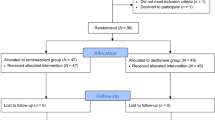Abstract
Purpose
Urapidil is an antihypertensive drug with actions of α1-receptor blockade and 5-HT1A (5-hydroxytryptamine) receptor stimulation. Although many agents have been used to attenuate the cardiovascular response to endotracheal intubation, few of them are related to urapidil. This study was done to evaluate the effects of urapidil on reducing the cardiovascular response to intubation.
Methods
In this randomized, double-blind, placebo-controlled study, 30 ASA I–II adult surgical patients without cardiovascular disease were divided into two groups of 15 each, receiving either an i.v. bolus of 0.6 mg·kg−1 urapidil 5 min before intubation or an equivalent volume of saline as control. The heart rate and the systolic and diastolic blood pressure were determined intermittently for 5 min before and 10 min after intubation. The mean blood pressure, product of systolic blood pressure and heart rate, and coefficient of variation (CV) of these variables around intubation were calculated.
Results
Urapidil had no effects on the heart rate (P>0.05), could effectively attenuate the increases in the diastolic and mean arterial pressures (P<0.05) caused by intubation, but had a weak effect on the systolic pressure (P>0.05) and its product with heart rate. In addition, the CV of the diastolic pressure and mean arterial pressure was greater (P<0.05) in the urapidil group than in the control group, which meant that the induction procedure with urapidil was not more stable than that when saline was used as placebo.
Conclusion
The effects of urapidil on reducing the cardiovascular response to intubation are mild when uradipil is used 5 min before intubation. As urapidil mainly decreases diastolic blood pressure, an important determinant of cardiac blood supply, and it makes systolic, diastolic, and mean blood pressure fluctuate strongly during induction, we should be alert about its latent detrimental effect on patients, especially those with ischemic heart disease.
Similar content being viewed by others
References
Prys-Roberts C, Greene LT, Meloche R, Foex P (1971) Studies of anesthesia in relation to hypertension. II: Haemodynamic consequences of induction and intubation. Br J Anaesth 43:531–547
Fox EJ, Sklar GS, Hill CH, Villanueva R, King BD (1977) Complications related to the pressor response to endotracheal intubation. Anesthesiology 47:524–525
Abou-Madi MH, Keszler H, Yacoub JM (1977) Cardiovascular reactions to laryngoscopy and tracheal intubation following small and large intravenous doses of lidocaine. Can Anesth Soc J 24: 12–19
Hamill JF, Bedford RF, Weaver DC, Colohon AR (1981) Lidocaine before endotracheal intubation: intravenous or laryngotracheal? Anesthesiology 55:578–581
Mikawa K, Ikegaki JI, Maekawa N et al. (1990) Effect of prostaglandin E1 on the cardiovascular response to tracheal intubation. J Clin Anesth 2:420–424
Stoelting RK (1979) Attenuation of blood pressure response to laryngoscopy and tracheal intubation with sodium nitroprusside. Anesth Analg 58:116–119
Sharma S, Mitra S, Grover VK, Kalra M (1996) Esmolol blunts the haemodynamic responses to tracheal intubation in treated hypertensive patients. Can J Anesth 43:778–782
Prichard BNC, Tomlinson B, Renondin JC (1989) Urapidil, a multiple-action alpha-blocking drug. Am J Cardiol 64:11D-15D
Sckook CE, Radtke H, Wurst W, Thieme G (1989) Overview of clinical trials with urapidil. Am J Cardiol 64:30D-37D
Kolassa N, Beller KD, Sanders KH (1989) Involvement of brain 5-HT1A receptor in the hypotensive response to urapidil. Am J Cardiol 64:7D-10D
Steib A, Collin F, Stojeba N, Coron T, Weber JC, Beller JP (1996) Use of urapidil during surgery for pheochromocytoma. Ann Fr Anesth Reanim 15:142–148
Van der Stroom JG, Van Wezel HB, Vergroesen I, Kal JE, Koolen JJ, Dijikhuis JP, Swaan A, Porsius M, Kleinjans AJ, Van Zwieten PA (1996) Comparison of the effects of urapidil and sodium nitroprusside on haemodynamic state, myocardial metabolism and function in patients during coronary artery surgery. Br J Anaesth 76:645–651
Quere JF, Ozier Y, Bringier J, Morot B, Bernard D, Pigot B, Conseiller C (1990) Does urapidil attenuate the blood pressure response to tracheal intubation for general anesthesia? Drugs 40[Suppl 4]:80–81
Puchstein C, Van Aken H, Zander J, Lawin P (1984) The use of urapidil in the postoperative period. Anaesthesist 33:224–227
Bielen E, Fagard R, Staessen J, Lijnen P, Van Hoof R, Amery A (1989) Urapidil-induced hemodynamic changes in humans Am J Cardiol 64:16D-21D
Van Zwieten PA (1988) Basic pharmacology of alpha-adrenoceptor antagonists and hybrid dogs. J Hypertens 6[Suppl 2]: s3-s11
Mastronardi P, Santagata T, Noseda A, Mazzarella B (1996) Prevention of hypertensive crises in the perioperative period. Efficacy and safety of the use of urapidil. Minerva Chir 51:227–233
Bellamy RF (1978) Diastolic coronary artery pressure-flow relations in the dog. Circ Res 43:91–101
Author information
Authors and Affiliations
About this article
Cite this article
Xu, X., Li, Y. Reduction of cardiovascular response to endotracheal intubation in normotensive patients by urapidil. J Anesth 12, 119–124 (1998). https://doi.org/10.1007/BF02480088
Accepted:
Issue Date:
DOI: https://doi.org/10.1007/BF02480088




